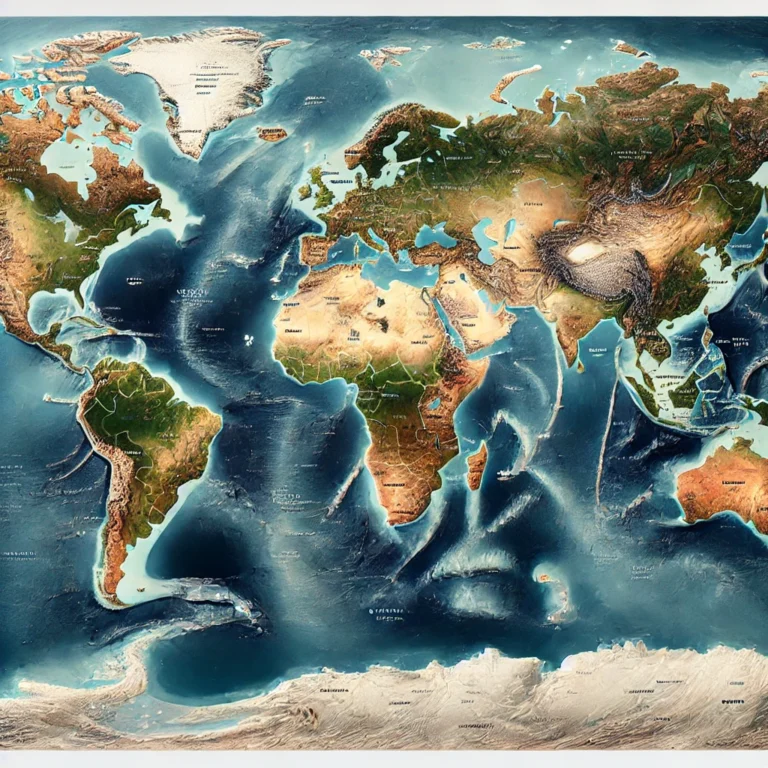Ocean Temperature
Suppose you are standing on a beach, feeling the cool breeze and watching the waves crash onto the shore. Now, think about this: why does ocean water not heat up as quickly as the land, and why does it feel cooler than the air even on a hot day? The answer lies in the complex yet fascinating science of ocean temperature.
🔥 What Determines Ocean Temperature?
The Sun is the primary source of heat for the ocean, just like it is for the land. However, unlike land, the ocean does not heat up or cool down quickly. The reason? Water has a high specific heat capacity, meaning it takes more energy to change its temperature compared to land.
But sunlight is not the only source! Some heat also comes from:
- The Earth’s interior (heat from below the ocean floor).
- Compression of water (deeper layers experience high pressure, which can generate some heat).
Just as a pot of water on a stove takes time to boil, the ocean also takes time to absorb and release heat. This is why ocean temperatures change slowly over time.
❄️ How Does the Ocean Lose Heat?
Just as a hot cup of tea cools down in three ways (radiation, evaporation, and conduction), the ocean also loses heat through:
- Back Radiation ☀️ → The ocean absorbs solar energy but later releases it back into the atmosphere as infrared radiation.
- Exchange of Heat with the Atmosphere 🌬️ → If the air above is colder, the ocean loses heat; if it’s warmer, the ocean absorbs heat.
- Evaporation 💧 → Water evaporates, taking heat away, just like sweat cools our body.
🌡️ Why Do Oceans Heat Up and Cool Down Slowly?
If you place a metal plate and a bowl of water under the sun, the metal heats up almost instantly, but the water remains cool. Similarly, oceans heat up and cool down much slower than land due to:
- Mixing of Water Layers: Unlike land, where heat stays on the surface, ocean water moves vertically and horizontally, redistributing heat.
- High Heat Capacity: Water absorbs more heat before increasing in temperature.
- Large Volume: The vastness of the ocean means heat spreads out over a massive area.
This is why coastal areas don’t experience extreme temperature variations—the ocean acts as a natural temperature regulator!
🌊 Factors Affecting Ocean Temperature Distribution
Just as different parts of a house feel warmer or colder depending on sunlight, insulation, and ventilation, the ocean’s temperature also varies due to multiple factors:
- Insolation (Sunlight Intensity) ☀️ → Equatorial regions receive direct sunlight, making them warmer than polar regions.
- Heat Loss Mechanisms 🌬️ → Reflection, evaporation, and radiation affect how much heat the ocean retains.
- Albedo Effect ⛅ → The angle of sunlight influences how much energy is absorbed or reflected.
- Salinity & Boiling Point 🌊 → Higher salinity raises the boiling point, reducing evaporation and affecting temperature.
- Ocean Shape & Depth 📍 → Large, open oceans retain more heat than narrow, enclosed seas.
- Weather Conditions 🌪️ → Cyclones, storms, and local winds impact temperature variations.
- Land-Water Distribution 🌍 → The Northern Hemisphere has more land, which retains heat, making oceans there warmer than in the Southern Hemisphere.
- Winds & Currents 💨 → Winds move warm or cold water, causing horizontal and vertical currents.
- Offshore winds (blowing from land to ocean) pull warm water away, allowing cold water to rise (upwelling).
- Onshore winds push warm water toward the coast, raising temperatures.
For example:
- Gulf Stream (warm current) increases temperatures near Eastern North America and Western Europe.
- Labrador Current (cold current) brings cold water near Canada’s east coast.
This is why London (UK) and Newfoundland (Canada), despite being at similar latitudes, experience vastly different climates!
🌍 Horizontal Temperature Distribution
Picture yourself at the equator, standing on the deck of your ship, feeling the intense tropical sun. You might assume this is where the ocean is the hottest. But surprisingly, the highest ocean temperatures are not exactly at the equator—they are slightly north of it! Why?
Factors Influencing Horizontal Temperature Distribution
- General Pattern: Warm at the Equator, Cold at the Poles
- On average, the surface temperature of the ocean is 26.7°C, but it gradually decreases as you move toward the poles.
- This is because the equator receives direct, intense sunlight, while the poles get oblique rays that spread over a larger area.
- Why is the Northern Hemisphere Warmer?
- If you compare the northern and southern hemispheres at the same latitude, the northern oceans are warmer.
- This is due to land-water distribution—the Northern Hemisphere has more land, which retains heat and influences nearby ocean temperatures. The Southern Hemisphere has more open oceans, which take longer to warm up.
- Why is the Warmest Water North of the Equator?
- One would expect the hottest ocean temperatures exactly at the equator, but instead, they are slightly north of it.
- This is because of heavy rainfall and cloud cover at the equator, which limit excessive heating. Meanwhile, the tropics (around 10–20° latitude) have drier, sunnier conditions, allowing the ocean to warm up more.
- How Do Ocean Currents Modify This Pattern?
- The story of ocean temperatures is not always predictable—warm and cold ocean currents disturb the general pattern.
- Warm currents like the North Atlantic Drift and Alaskan Current transport warm water to higher latitudes, making mid-latitude regions warmer than expected.
- Cold currents like the Labrador Current (near Canada) and the Humboldt Current (off South America) bring cold water into warm regions, cooling them down significantly.
- Upwelling Zones: In some places, deep cold water rises to the surface due to wind patterns, lowering temperatures dramatically.
Thus, while the equator-to-pole temperature trend is predictable, local ocean currents and winds create exceptions, making some places warmer or colder than expected.
🌊 Vertical Temperature Distribution
Now, let’s dive deep into the ocean and see how temperature changes with depth. Unlike land, where heat stays at the surface, the ocean has a unique structure—with warm water at the top and icy depths below.
Why is the Surface the Warmest?
- The sun’s rays can only penetrate up to 200m in clear ocean water. This means that the ocean’s heat source is entirely from above.
- The deeper layers receive no direct sunlight—so their temperature depends on how well heat is transferred downward.
Three-Layered Structure of the Ocean
In the tropics and mid-latitudes, the ocean is divided into three distinct temperature layers:
- Surface Warm Layer (~500m thick, 20–25°C) ☀️
- This is the topmost layer that receives direct sunlight.
- It is present year-round in the tropics but appears in mid-latitudes only in summer when the sun is stronger.
- Thermocline Layer (Zone of Rapid Cooling) 🌡️
- Below the surface layer, temperature drops very quickly. This zone is called the thermocline.
- The deeper you go, the colder it gets, but this transition is not uniform—it happens sharply in the thermocline zone.
- Deep Cold Layer (Extending to the Ocean Floor, ~4°C) ❄️
- This layer extends from below the thermocline all the way to the ocean bottom.
- It remains almost uniformly cold, with temperatures near freezing.
What About Polar Regions?
- If you dive into the Arctic or Antarctic oceans, you won’t find these three layers.
- Instead, the entire water column is uniformly cold from top to bottom because these regions receive very little solar heating.

🏁 Final Thoughts
Understanding ocean temperature helps us predict climate patterns, manage fisheries, and understand global weather phenomena like El Niño. Just as our body maintains a stable temperature despite changing environments, the ocean acts as Earth’s thermostat, balancing heat distribution across the planet.
UPSC sample Question
Q. Despite being located at similar latitudes, London (UK) and Newfoundland (Canada) experience starkly different climatic conditions. Discuss the factors responsible for these climatic variations, with a special emphasis on ocean currents and atmospheric circulation. (250 words)
Answer
Despite being located at similar latitudes, the United Kingdom (UK) and Newfoundland (Canada) experience vastly different climatic conditions. This variation is primarily due to ocean currents, atmospheric circulation, and continentality.
1. Influence of Ocean Currents
- The UK is warmed by the Gulf Stream, which transports warm tropical waters across the Atlantic, leading to milder winters and cooler summers.
- In contrast, Newfoundland is influenced by the cold Labrador Current, which brings Arctic waters southward, resulting in colder temperatures and harsher winters.
2. Role of Atmospheric Circulation
- The UK lies in the path of the Westerlies, which carry moist, warm air from the Atlantic, contributing to a temperate maritime climate with frequent rainfall.
- Newfoundland, however, is affected by cold Arctic air masses, leading to colder winters, heavy snowfall, and greater temperature extremes.
3. Impact of Continentality
- The UK is an island nation, where surrounding water regulates temperature, ensuring moderate climatic conditions.
- Newfoundland, despite being coastal, is more influenced by the North American landmass, which experiences rapid heating and cooling, leading to more extreme seasonal variations.
Conclusion
The stark climatic contrast between the UK and Newfoundland highlights the critical role of ocean currents, wind patterns, and land-sea distribution in shaping regional climates. The UK enjoys a relatively mild maritime climate, while Newfoundland faces harsher, more extreme conditions due to Arctic influences and the Labrador Current.






